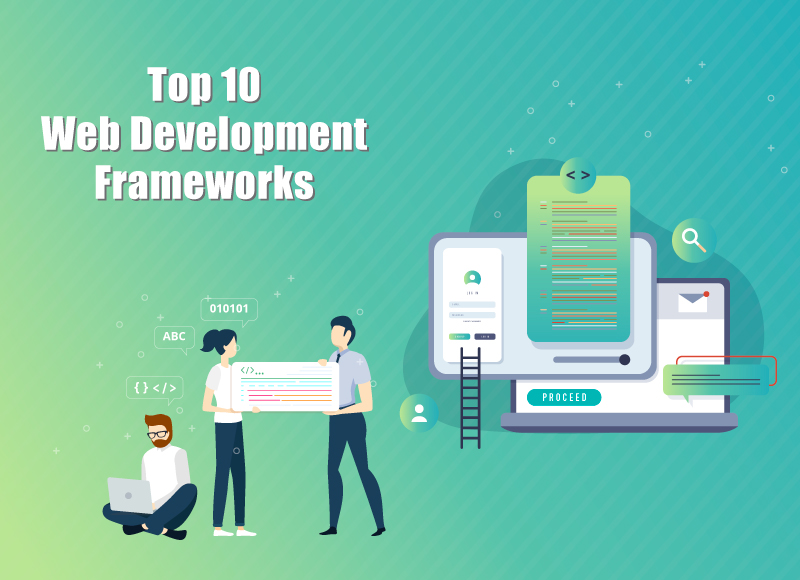Table of Contents
The knowledge of HTML and CSS has invariably been the basis of web development for years. These skills are still essential, but as in every modern programming technology, things have been covered by a higher level of abstraction to give developers tools t

The knowledge of HTML and CSS has invariably been the basis of web development for years. These skills are still essential, but as in every modern programming technology, things have been covered by a higher level of abstraction to give developers tools that would let them create better software in a more performant and safe way. There are many frameworks designed to support web application development. But what exactly is a web development framework? It is a solution that helps construct internet applications and functions according to the architectural rules of browsers and mostly HTTP communication protocol.
Frameworks or development libraries are nothing more than packages or collections of programmable solutions and programs that help develop an application. Thanks to the framework or library, developers could easily use web resources and APIs to build web services. As a result, development time has been significantly shortened by, for example, facilitated everyday activities performed in web development compared to the standard way of building and deploying web applications. Most frameworks have their own libraries enabling access to the database, which contains information about the structure of the templates used, and session management. It can be useful in both cases, dynamic websites, and static websites.
Typically, frameworks act as an extension of the capabilities of a given programming language or a tool or a set of solutions for an application of a given type, e.g., CMS, mobile development tools, or web application.
The following statistics are the best proof of the popularity of the usage of frameworks and development libraries:
- 1,850,673 detections of frameworks in the Top 1 million sites from around the world – according to BuiltWith,
- the total number of React downloads in the last two years exceeds 6 million. For Vue and Angular, this value is over a million downloads – according to report by Tecla.
- in 2018, almost 80% of the surveyed developers declared that they use or want to start using React, over 70% with Vue, and over 30% with Angular – according to stateofjs.
If you work as a programmer, you certainly use various frameworks on a daily basis, and you are familiar with the subject of this article. However, it is possible that you are just starting to be interested in this topic or are looking for additional information that will bring you closer to the world of web development frameworks. If so, below is a list of the top web development frameworks that will rule 2021.
React JS – a JavaScript library considered as a web development framework
React JS is not a framework. As per its official website, It is a Javascript library for building user interfaces. Although it is not a framework, many developers consider it as a framework.
React was developed by Facebook and maintained and supported with the help of a community of individual developers and companies. Facebook and Instagram applications use this library, so it is understandable that React is that popular.
Fundamental concepts of React are declarative programming, component-based, Virtual DOM, and it could be used in NodeJS or mobile apps as React Native.
Thanks to React’s declarativeness, simple views will be rendered efficiently, i.e. only when the data changes. The process happens with Reconciliation. Moreover, it improves code predictability.
The component-based approach builds encapsulated components that manage their state and make a composition. It could be easily used by passing data through the application without involving the DOM.
According to hotframeworks.com, interest in React has been growing steadily since 2016.
Vue.js – one of the newest and the most popular frameworks in web development
Vue.js is one of the newest and most popular frameworks in web development.
It is known as a progressive framework for building user interfaces, which means that it could be used in small parts of a project without any problems.
Also, Vue.js could act as the primary and only front-end framework in web development. The framework has specific libraries that provide functionalities to build the application in just Vue.js.
Vue.js’ main concepts are the Component system, Two-way binding, and the same as React – Virtual DOM.
The component system is one of the main concepts in Vue.js. It provides the possibility to build large-scale applications with reusable, self-contained smaller components.
Two-way binding is supported, which reduces the complexity of keeping user input consistent with the application data model.
Unlucky, this framework is not supported by significant commercial communities like React or Angular. However, Vue.js’ popularity in web development is continually growing, so it will be a big chance for some more prominent companies like Google or Facebook.
According to 2019.stateofjs.com, the use of Vue.js among developers worldwide increased by as much as 33 percent from 2016 to 2019.
Angular – an application design framework and development platform
Angular is an application design framework and development platform for creating efficient SPAs. It is developed and maintained by Google.
The main concepts of Angular are components, templates, directives, and dependency injection.
Components are basic UI blocks of an Angular application. The application contains a tree of components. Also, a component is a subset of directives, which is always associated with a template. Only one component can be instantiated for a given element in a template.
The template is an HTML section that could be included as part of the browser’s displayed page.
Directives are markers on a DOM element (attribute, element name, CSS class, or comment) and tell Angular’s compiler to attach particular behavior to this element in DOM or even modify this element and its children in DOM.
Dependency Injection is a software design pattern in which one object receives other objects that it depends on. In Angular, an injector subsystem is responsible for creating components, resolving their dependencies, and providing them to other components if needed.
Angular occurs as AngularJS framework and Angular 2, but they are separate entities.
Express – a trendy framework used in back-end web development
Express is a prevalent framework used in back-end web development. The framework is a minimal and flexible Node.js web application framework that provides fundamental web application features without limiting Node.js.
The main features of the express are Routing, Middlewares, Templating, and much faster server-side development.
Because of the minimalism of express, some developers implemented many middleware packages that solve almost every web development problem.
Besides that, Express is based on Javascript and is chosen by many developers who want to keep their back end applications at a high level of development.
Spring – the most popular back-end web application framework
Spring is the most popular back-end web application framework in Java.
This framework offers an extensive development and configuration pattern for latest Java-based enterprise applications on different deployment platforms.
The framework is used not only in big complex projects in the biggest companies but also by individual programmers who want to create scalable web applications.
Spring has many useful features, but the most powerful are dependency injection, events, data binding, and resources.
Dependency injection is a pattern through which to implement IoC, where the control being inverted is the setting of the object’s dependencies.
Events in Spring are by default synchronous. It means that the listener can participate in the publisher’s transaction context.
Data Binding is useful for allowing user input to be dynamically bound to an application’s domain model.
Aspect-Oriented Programming (AOP) separates cross-cutting concerns from the business logic of the application. For example, it could be used in logging or security.
Django – a high-level Python Web framework
Django is an advanced Web framework based on Python programming language that relies on fast development thanks to a clean and practical approach to the design. Its creators are experienced programmers who were aware of most of the most common problems related to web development, which is why the framework they created is a response to well-known needs. This allows you to save time and focus completely on writing the application.
Django is fast, fully loaded, reassuringly secure, incredibly versatile, and exceedingly scalable.
Companies and organizations of all sizes use Django in a variety of ways. This framework is useful when building science platforms, content management systems, or other applications.
Laravel – a PHP framework that became popular in a short period of time
Laravel is a PHP framework that became popular in a short period of time. It helps to create web applications more shortly and easily.
Laravel is extremely easy to use. Some amenities help develop apps from scratch with the database, security, and testing sections.
All that is needed to start is the Composer to manage its dependencies. After a specific setting configuration, the application is ready to make some changes without implementing basic authentication or DB connection.
Laravel has many built features like authentication, template engine, database migration system, a command-line tool called Artisan.MVC architecture is also supported, which means that it helps separate business logic and presentation layers.
Rails – a web app development framework written in the Ruby programming language
Rails – a framework for web app development that uses a specific programming language – Ruby. It is designed to make programming web applications more accessible by making assumptions about what every developer needs to start. It allows developers to write less code while having more features than many other languages and frameworks.
Rails only have two major principles :
- Do Not Repeat Yourself: it means that “Every piece of knowledge must have a single, unambiguous, authoritative representation within a system.” By making code more reusable, it is more maintainable and less buggy.
- Convention Over Configuration or coding by convention is a concept in which the best way is to focus on adapting to logical situations by default rather than creating own rules each time. It would help programming to be easier.
Also, Rails was implemented in MVC architecture, the most famous architecture in the back-end side of web development.
Flask – a micro-framework written in Python
Flask is written in Python and is known as a micro-framework because it does not need any specific tools and libraries. There is no database abstraction, verification of correctness of forms, or other components, but it operates extensions that could add some functionalities like Flask.
Flask aims to keep the core extensible but straightforward and does not force anything particular, so this framework could be everything you need and nothing you do not.
Besides Flask is micro-framework, it is used in applications like LinkedIn and Pinterest.
Symfony is a PHP web application framework based on MVC architecture and a set of reusable PHP components and libraries.
Symfony – a PHP web application framework based on MVC architecture
This framework’s main advantages are that it is one of the fastest PHP frameworks and allows developers to code in the Object-Oriented Programming paradigm with the possibility to use sessions.
Additionally, Symfony uses a scaffolding method that builds applications using databases. This concept assumes that developers create specifications describing the structure of databases and compilers generate code that can read or update records in the database.
A crucial feature of Symfony is that it has a Bundle System. It provides a choice of specific bundles (known as plugins in other programming languages). Developers can implement fully-functional web applications with an easy way to optimize the full implementation.
Summarizing
The above ranking is a subjective list of popular and most useful web development frameworks in our opinion. We hope that the information collected here has allowed you to broaden your knowledge about frameworks and will encourage you to get acquainted with some of them. The use of frameworks is the bread and butter of a web developer. The ability to use selected frameworks can significantly facilitate and speed up your work. Their popularity is growing year by year, and knowing some of them is a fundamental skill required of a developer. The efficient use of frameworks will allow you to improve your work on web development, stand out from most developers, and get more exciting employment and better earnings.









